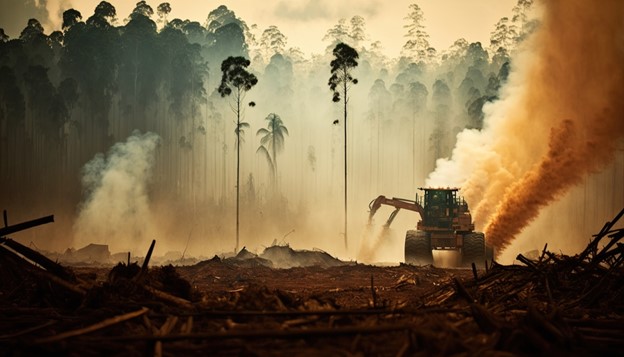Deforestation, the process of clearing and destroying forests, has become a global environmental crisis. It is particularly alarming in its impact on the world’s biodiversity, with a significant focus on endangered species. Carbon Green Investments explores the specific consequences of deforestation in different regions of the world, highlighting the alarming rate at which it contributes to the extinction and endangerment of local wildlife.
Understanding Deforestation
Deforestation involves the conversion of forested land to non-forested areas for various purposes like agriculture, urban development, and logging. This phenomenon is most prevalent in biodiverse-rich tropical regions, such as the Amazon Basin in South America, the Congo Basin in Africa, and Southeast Asia. These regions are not only rich in plant life, but also host a vast array of animal species, many of which are now at risk due to the rapid loss of their natural habitats.
Innovative Strategies for Biodiversity Preservation in the Wake of Deforestation
In the face of the severe biodiversity loss due to deforestation, innovative conservation strategies are emerging, highlighting the potential of technology, community involvement, and interdisciplinary approaches to mitigate these effects. Leveraging drones, satellite imagery, and AI for ecosystem monitoring, empowering local communities through integration of traditional knowledge with conservation efforts, and employing interdisciplinary research to inform comprehensive conservation models are proving effective. Additionally, restoration and rewilding of degraded habitats, alongside global cooperation and policy integration, are essential. These strategies underscore a hopeful path forward, emphasizing the necessity of a collaborative, multifaceted approach to preserving biodiversity amidst ongoing deforestation challenges.
The Multi-faceted Impact on Wildlife
- Habitat Loss and Its Direct Consequences
The primary and most immediate effect of deforestation is habitat loss. Forests provide essential resources for wildlife, including food, shelter, and breeding grounds. The clearance of these areas forces countless animals to relocate, often to less suitable environments where they will struggle to survive. This displacement leads to a substantial decrease in population numbers and, in severe cases, can drive species towards extinction.
- Species-Specific Impacts
Orangutans in Indonesia and Malaysia: These primates are critically endangered, primarily due to the conversion of their rainforest habitat into palm oil plantations.
The Amazonian Jaguar: The ongoing deforestation in the Amazon has led to a reduction in the population of jaguars, primarily due to habitat fragmentation and a decrease in prey availability.
- Fragmentation: The Silent Threat
Deforestation often leads to the fragmentation of once vast and continuous forests into smaller, isolated patches. This fragmentation restricts the movement of species, limiting their access to resources and mates. It also increases the vulnerability of these isolated populations to external threats such as poaching and climate change.
- The Indirect Effects of Climate Change
Deforestation contributes to climate change by reducing the Earth’s capacity to sequester carbon dioxide. This leads to altered climate patterns, which directly affect wildlife by disrupting natural processes like migration, breeding, and feeding.
Regional Case Studies Highlighting the Crisis
- The Amazon Rainforest
Often referred to as the Earth’s lungs, the Amazon rainforest is experiencing unprecedented levels of deforestation. This has dire implications for species like the Amazonian manatee, the golden lion tamarin, and numerous other species of birds, amphibians, and insects. The loss of such rich biodiversity impacts not only the ecological balance, but the health of the forest itself as well.
- Southeast Asian Rainforests
In Southeast Asia, deforestation, mainly for palm oil production, has put species like the Sumatran tiger and Bornean elephant at risk. The loss of habitat and the ensuing human-wildlife conflict due to agricultural expansion have severely threatened the survival of these species.
- African Forests
African forests, particularly in the Congo Basin, are being deforested for timber and to make way for agricultural land. This deforestation threatens species like the forest elephant and lowland gorilla, along with countless endemic species of flora and fauna that are integral to the ecosystem’s health.
Mitigation and Conservation Strategies
- International and Regional Initiatives
Efforts like the United Nations’ REDD+ program and conservation campaigns led by organizations like the World Wildlife Fund play a crucial role in combating deforestation. National parks and wildlife reserves also offer a sanctuary for endangered species, although they face challenges like underfunding and illegal activity.
- Empowering Local Communities
Involving local communities in conservation efforts and promoting sustainable land-use practices are critical. Education on sustainable farming techniques and the benefits of ecotourism can provide economic incentives for forest conservation.
- Legal Frameworks and Enforcement
Strengthening legal protections for endangered species and enforcing laws against illegal logging and wildlife trade are essential. International cooperation is necessary to combat these transboundary issues effectively.
Deforestation is a complex global issue with profound local impacts, particularly on endangered species. The situation calls for a concerted effort from governments, conservation groups, local communities, and individuals. It’s a collective responsibility to ensure the survival of our planet’s biodiversity. Active and sustained conservation efforts are imperative to mitigating the effects of deforestation and preserving the natural habitats of endangered species for future generations. This is not just an environmental issue but a moral responsibility to maintain the balance of our planet’s ecosystems.
